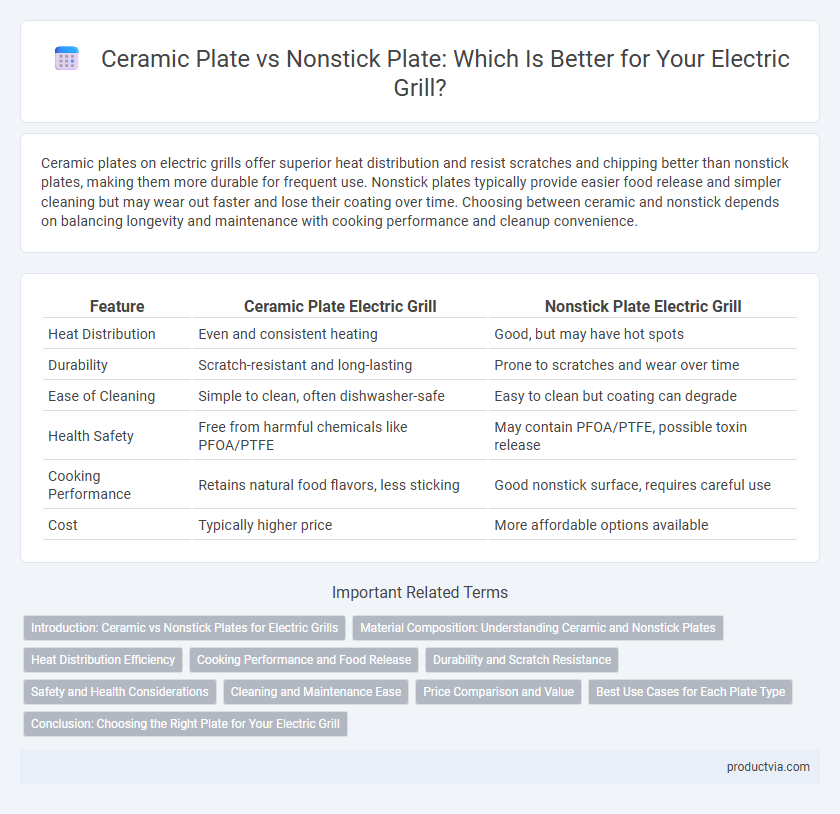Ceramic plates on electric grills offer superior heat distribution and resist scratches and chipping better than nonstick plates, making them more durable for frequent use. Nonstick plates typically provide easier food release and simpler cleaning but may wear out faster and lose their coating over time. Choosing between ceramic and nonstick depends on balancing longevity and maintenance with cooking performance and cleanup convenience.
Table of Comparison
| Feature | Ceramic Plate Electric Grill | Nonstick Plate Electric Grill |
|---|---|---|
| Heat Distribution | Even and consistent heating | Good, but may have hot spots |
| Durability | Scratch-resistant and long-lasting | Prone to scratches and wear over time |
| Ease of Cleaning | Simple to clean, often dishwasher-safe | Easy to clean but coating can degrade |
| Health Safety | Free from harmful chemicals like PFOA/PTFE | May contain PFOA/PTFE, possible toxin release |
| Cooking Performance | Retains natural food flavors, less sticking | Good nonstick surface, requires careful use |
| Cost | Typically higher price | More affordable options available |
Introduction: Ceramic vs Nonstick Plates for Electric Grills
Ceramic plates in electric grills offer superior heat retention and distribute heat evenly, preventing hotspots for consistent cooking results. Nonstick plates provide easy food release and quick cleanup due to their synthetic coating, but may wear out faster under high heat. Choosing between ceramic and nonstick depends on cooking preferences, durability needs, and maintenance willingness for optimal electric grill performance.
Material Composition: Understanding Ceramic and Nonstick Plates
Ceramic plates for electric grills are made from natural minerals and coated with a silica-based layer, offering superior heat distribution and resistance to high temperatures without releasing harmful chemicals. Nonstick plates typically consist of an aluminum base with a polytetrafluoroethylene (PTFE) coating, which provides easy food release but can degrade at high heat and potentially emit toxic fumes. Choosing between ceramic and nonstick materials depends on desired durability, heat tolerance, and health safety preferences for optimal grilling performance.
Heat Distribution Efficiency
Ceramic plates in electric grills provide superior heat distribution efficiency due to their ability to retain and evenly disperse heat, resulting in consistent cooking temperatures across the surface. Nonstick plates, often coated with PTFE or similar materials, may heat unevenly and lose effectiveness over time, impacting the uniformity of heat distribution. Enhanced heat retention in ceramic plates minimizes hot spots and ensures better cooking performance compared to conventional nonstick alternatives.
Cooking Performance and Food Release
Ceramic plates on electric grills provide superior heat retention and even cooking, enhancing sear marks and minimizing hot spots compared to nonstick plates. Food release on ceramic plates is naturally effective due to their smooth surface, reducing sticking without requiring excessive oil. Nonstick plates offer good non-stick properties initially but may degrade faster, affecting cooking performance and increasing food residue buildup over time.
Durability and Scratch Resistance
Ceramic plates for electric grills offer superior durability and exceptional scratch resistance compared to nonstick plates, maintaining their surface integrity even after extensive use with metal utensils. Nonstick plates, typically coated with PTFE or similar materials, tend to degrade faster when exposed to scratches and high heat, reducing their lifespan significantly. Choosing ceramic plates ensures a longer-lasting grilling surface that withstands rough handling without compromising performance.
Safety and Health Considerations
Ceramic plates for electric grills offer a non-toxic, chemical-free cooking surface that resists scratches and high temperatures, reducing the risk of harmful fumes compared to some nonstick coatings containing PTFE or PFOA. Nonstick plates provide easy food release but may degrade under extreme heat, potentially releasing toxic compounds that pose health risks. Choosing ceramic plates enhances safety and health by minimizing exposure to toxic substances and promoting cleaner cooking environments.
Cleaning and Maintenance Ease
Ceramic plates on electric grills offer superior non-stick properties that facilitate effortless cleaning, often requiring only a simple wipe with a damp cloth. Nonstick plates, while also convenient, can degrade over time and may necessitate gentle cleaning to prevent surface damage. Both options reduce cooking residue buildup, but ceramic plates typically maintain their smooth surface longer, enhancing durability and ease of maintenance.
Price Comparison and Value
Ceramic plates for electric grills typically cost more upfront than nonstick plates but offer superior heat distribution and longer durability, enhancing cooking performance over time. Nonstick plates are more affordable initially, making them suitable for budget-conscious consumers, yet they may wear out faster and require frequent replacement. Considering long-term value, ceramic plates often provide better return on investment due to their resilience and consistent cooking results, despite the higher price point.
Best Use Cases for Each Plate Type
Ceramic plates on electric grills excel in high-heat cooking and searing, offering excellent heat retention and even distribution, ideal for grilling steaks and vegetables. Nonstick plates are best suited for low to medium-heat cooking with delicate foods like fish or eggs, providing easy release and simplified cleanup. Choosing between ceramic and nonstick depends on cooking style: ceramic for intense grilling and nonstick for gentle, fuss-free cooking.
Conclusion: Choosing the Right Plate for Your Electric Grill
Ceramic plates for electric grills offer superior heat retention and scratch resistance, making them ideal for high-temperature cooking and durability. Nonstick plates provide easier food release and quicker cleanup, suitable for everyday grilling with less maintenance. Selecting between ceramic and nonstick plates depends on your cooking habits, prioritizing longevity and even heat or convenience and effortless cleaning.
Ceramic plate vs nonstick plate for electric grill Infographic

 productvia.com
productvia.com